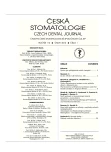The Occurrence of Streptococcus Mutans and Oral Health Condition in Pregnant Women
Authors:
H. Hecová 1; V. Merglová 1; J. Stehlíková 1; P. Chaloupka 2
Authors‘ workplace:
Stomatologická klinika LF UK a FN, Plzeň
1; Gynekologicko-porodnická klinika LF UK a FN, Plzeň
2
Published in:
Česká stomatologie / Praktické zubní lékařství, ročník 112, 2012, 1, s. 6-14
Category:
Original Article – Retrospective Essay
Overview
Introduction:
Occurrence of cariogenic microorganisms in the oral cavity is considered as a major etiologic factor causing dental caries. Cariogenic SM streptococcal exposure is significantly affected both by carbohydrates in diet and saliva buffer capacity.
Aims:
The aim of this study was to investigate the dental status of pregnant women, to determine the saliva buffer capacity, and to identify the occurrence of Streptococcus mutans (SM) quantity in saliva and plaque. The frequency of carbohydrate intake in between meals among pregnant women was taken as a base for the risk determination of new carious lesions.
Materials and methods:
The study included 61 women with a physiological pregnancy (group F) and 81 women with a risk pregnancy (group R). The age range of women in both groups was 21 to 40 years.
Results:
The study results showed following: the risk values of SM in saliva were detected in 65.5% of women with a physiological course of pregnancy and in 70.3% of women with a risk course of pregnancy. The risk values of SM in the plaque were found in 82% of women in group F and in 85.2% of women in group R. The low saliva buffer capacity was found in 51 pregnant women. The middle saliva buffer capacity was detected in 51 pregnant women.
The average value of the DMF amounted to 11.3 and 12.8 in women of F and R groups respectively.
Untreated caries occurred in 94 pregnant women (52.5% in physiologic pregnancy and 76.5% in risk pregnancy).
Dental caries destruction resulted in an extraction in 4 women (group F) and 10 women (group R). High risk of new caries lesions were found more frequently in the women with risk pregnancy (71.6). The differences in salivary and plaque levels of SM and saliva buffer capacity between groups of women with physiological and risk course of pregnancy were not statistically significant. Nevertheless the need of dental treatment in women at risk pregnancy was statistically significantly higher than in women at physiological pregnancy (P = 0.0027).
Conclusion:
The study has emphasized the need of increased attention during preventive dental appointments particularly in women with a risk course of pregnancy.
Key words:
Streptococcus mutans – pregnancy – dental caries
Sources
1. Axelsson, P.: Diagnosis and risk prediction of dental caries. Berlin, Quintessence, 2000, s. 18–29, 108–120.
2. Axelsson, P., Kristoffersson, K., Karlsson, R., Bratthall, D.: A 30-month longitudinal study of the effects of some oral hygiene measures on Streptococcus mutans and approximal dental caries. J. Dent. Res., roč. 66, 1987, s. 177–180.
3. Aguilera Galaviz, L. A., Premoli, G., Gonzalez, A., Rodriguez, R. A.: Caries risk in children: determined by levels of mutans streptococci and Lactobacilus. J. Clin. Pediatr. Dent., roč. 29, 2005, č. 4, s. 329–333.
4. Berkowitz, R. J.: Causes, treatment and prevention of early childhood caries. A microbiologic perspective. J. Can. Dent. Assoc., 69, 2003, č. 5, s. 304–307.
5. Fitzgerald, R., Keyes, P.: Demonstration of the etiologic role of streptococci in experimental caries in the hamster. J. Am. Dent. Assoc., roč. 61, 1960, s. 9–19.
6. Gibbons, R.: Bacterial adhesion to oral tissues. A model for infectious diseases. J. Dent. Res., roč. 68, 1989, s. 750–760.
7. Jaklová, H., Nováková, K.: Streptococcus mutans v ústní dutině a kazivost chrupu. Prakt. zub. Lék., roč. 58, 2010, č. 5, s. 65–67.
8. Köhler, B., Andréen, I.: Influence of caries-preventive measures in mothers on cariogenic bacteria and caries experience in their children. Archives of Oral Biology, roč. 39, 1994, č. 10, s. 907–911.
9. Lindquist, B., Emilson, C., Wennerholm, K.: Relationship between mutans streptococci in saliva and their colonization of tooth surfaces. Oral Microbiol. Immunol., 1989, č. 4, s. 71–76.
10. Kilian, J., a kol.: Prevence ve stomatologii. 2. vyd., Praha, Galén, 1999.
11. Merglová, V.: Prenatální prevence zubního kazu. Praktická gynekologie, roč. 12, 2008, č. 3, s. 150–153.
12. Merglová, V., Hecová, H., Stehlíková, J., Chaloupka, P.: Stav orálního zdraví žen s fyziologickým a rizikovým těhotenstvím – předběžné výsledky. Čes. Stomat., roč. 110, 2010, č. 3, s. 69–74.
13. Merglová, V., Ivančaková, R.: Zubní kaz v raném dětství. Pediatrie pro praxi, roč. 10, 2009, č. 6, s. 394–396.
14. Meurman, J. H., Furuholm, J., Kaaja, R., Rintamaki, H., Tikkanen, U.: Oral health in women with pregnancy and delivery complications. Clin. Oral. Invest., 2006, s. 96–101.
15. Russell, S. L., Ickovics, J. R., Yaffee, R. A.: Parity and untreated dental caries in US Women. J. Dent. Res., roč. 89, 2010, s. 1091–1096.
Labels
Maxillofacial surgery Orthodontics Dental medicineArticle was published in
Czech Dental Journal

2012 Issue 1
Most read in this issue
- Advantages and Disadvantages of Dental Miniimplants – Ten Different Viewpoints
- Cleft Lip and Palate, the Initial Phase of Treatment Planning and Interdisciplinary Therapy for Patients in the Neonatal Age
- Advances in the Pharmacotherapy of Periodontal and Oral Mucosal Diseases
- The Use of Imaging Methods in the Diagnosis of Bisphosphonate-related Osteonecrosis of the Jaw
